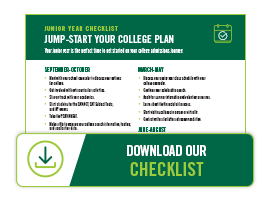Preparing for College: Junior Year Checklist
By Jen Carlevatti | Last Updated: Mar 5, 2025

Are you dreaming of senior year, that magical time when you’ll FINALLY rule the roost? It may seem like it’s a long way off, but in a few short months, your final year of high school will be upon you — and so will college applications. While it’s tempting to put “all things college” on the back burner until next fall, preparing for college during your junior year is a smart strategy that can reduce stress, help you stay on track, and increase your chances of admission.
Here are eight items that should be on every junior’s college planning checklist.
Talk With Your College Counselor About How to Prepare for College
Do you walk straight past your college counselor’s office every day? Now is the time to stop in for a chat. Your counselor has helped countless students get admitted to college, and they can do the same for you. From helping you choose senior year courses that colleges require to advising on admission requirements to exploring ways to pay for college, your counselor is an invaluable resource who can show you how to prepare for college successfully.
 Make a First Draft of Your College List
Make a First Draft of Your College List
Junior year is a great time to start researching potential colleges and compiling your initial college list. For now, keep the list broad – you’ll have time to whittle it down over the summer, ideally after you’ve gathered more information about each school. Most counselors recommend creating a balanced list composed of safety, target, and reach colleges:
- Safety colleges are institutions where your GPA, test scores, and class rank are above the average range of the most recently admitted freshman class.
- Target colleges are institutions where your GPA, test scores, and class rank fall within the average range of the most recently admitted freshman class.
- Reach colleges are institutions where your GPA, test scores, and class rank fall at the lower end of, or below, the average range of the most recently admitted freshman class.
Before adding a college to your list, be sure to consider whether it’s affordable and whether you can see yourself being happy there for four years. Factors such as a college’s size, location, amenities, and student life can be just important as academics.
Visit Colleges, In-Person or Virtually
Now that you’ve developed your initial list, spend the rest of your junior year visiting as many campuses as possible. Take the official tour. Explore campus on your own. Talk to students. Eat in the dining hall. It’s the best way to get a sense of what it’s really like to attend a college and gather information you won’t find online.
If you can’t visit in person, most colleges have developed robust virtual tours that explore the highlights on campus, from classrooms to residence halls to student centers. No travel is required, they’re free, and you can virtually visit any time.
 Attend College Fairs
Attend College Fairs
Attending a college fair is an efficient way to gather information about multiple colleges at one time and connect directly with admissions reps – all without traveling to campus. Make a plan for how to get the most out of each fair so you don’t get overwhelmed or forget important information. To find out about upcoming college fairs in your area, visit the NACAC college fairs website or the College Fair Guide.
Consider Registering for the SAT or ACT
Hundreds of colleges have gone “test-optional.” However, there are still plenty of reasons to sign up for the SAT or the ACT.
Highly selective institutions still require test scores, and they may be required to qualify for scholarships or other financial aid based on academic merit. Additionally, test-optional schools will consider your scores if you submit them, and if you scored well, it could reflect favorably on your application. If you’re still on the fence, here are a few reasons you may want to opt-in or opt-out of testing.
Get Involved in an Activity or Volunteer
Have you joined a school club or do you volunteer in your community? If so, now is a great time to step up to a leadership role with your group. If not, get involved in something that interests you, be it a club, a team, a community organization, or your church. These activities demonstrate your interests outside of class, and many colleges consider involvement in extracurriculars as part of their admission decisions.
Discuss College Affordability With Your Family
The cost of college can have an outsized impact on your life for decades. That’s why it’s important to discuss college affordability with your family before you begin applying for admission. Choosing a college that’s a good financial fit is just as important as finding a college that’s a good academic fit.
If finances are a taboo topic in your house, here are some tips to help you start the conversation. Some items to consider:
- How much can you and your family contribute to college?
- Are student loans an option?
- How much borrowing is reasonable (i.e., can be paid back within 10 years of graduation)?
- Are prepaid college funds available, and if so, which colleges accept them?
- Are strings attached to the support your parents provide, such as your attendance at a particular college?
These can be hard conversations, but they’re critical to avoiding surprise and disappointment at the end of the college admission process.
Learn About the Financial Aid Process
After discussing affordability with your family, you may decide you need help offsetting some college costs. Now is the time to get familiar with the process of applying for financial aid:
- Find out some of the key terminology used in the process, including Free Application for Federal Student Aid (FAFSA), Expected Family Contribution (EFC), CSS profile, etc.
- Explore the different types of aid and how to apply for them, including grants, scholarships, loans, and work study awards.
- Learn about the concept of net price (a college’s full cost of attendance minus any gift aid).
- Research the specific financial aid application requirements at each college on your list, including documentation needed and the submission deadlines.
The more you find out about the process now, the easier (and less stressful) it will be to apply in the fall.
Want more information about applying for financial aid at USF? The Office Financial Aid website has a wealth of resources to consider, and our admissions advisors stand ready to answer your questions. Reach out any time to start the conversation at admissions@usf.edu or 813-974-3350.



